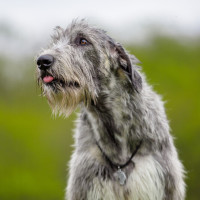Appearance of the Standard Irish Wolf Schnauzer
|
| The Standard Irish Wolf Schnauzer is a large designer dog and is a cross between a purebred Irish Wolfhound and a purebred Standard Schnauzer. Common colors can include black, salt and pepper, gray, red, white and fawn. Their coat is likely to be rough and stiff. The Standard Irish Wolf Schnauzer typically weighs between 22.5 and 52 kilos and reaches a height of up to 71 centimeters. Your pet is likely to have shaggy eyebrows over dark brown eyes with an alert but gentle expression. He's also likely to have the distinctive Schnauzer beard. Although a strong, muscular dog, it is also likely to be quite graceful. |
Temperament of the Standard Irish Wolf Schnauzer
|
| A Standard Irish Wolf Schnauzer is an affectionate, intelligent dog that does best when it spends a lot of time with its family. These dogs are sensitive and don't do well left in a yard, so they're best suited to people who will devote time to their dog. The Standard Irish Wolf Schnauzer is gentle and gets on very well with children and other dogs, but early socialization and training is always a good idea. These dogs are loyal and protective of their families. They can be a little wary of strangers and will always bark to alert you if a stranger approaches. They are fairly easy to train and will be very sensitive to lots of praise and positive reinforcement. But they can have a stubborn Schnauzer side, so patience may be required. They are recommended for those who have some experience with dogs. They are energetic dogs but don't need a very intense exercise regime, although they do need a good amount of daily activity. |
Needs and activities of the Standard Irish Wolf Schnauzer
|
| The Standard Irish Wolf Schnauzer will need plenty of exercise to stay fit and healthy. He'll love joining you for long walks to the beach or dog park, but make sure he's on a leash on your way so he doesn't run off after small dogs. The Standard Irish Wolf Schnauzer will love to play ball games and will do best in a home that has a fenced garden in which he can play and explore. Make sure you don't exercise your dog after a big meal, as they suffer from bloat. They can be very sensitive to heat, so also try not to exercise your pet in the heat of the day, especially in summer. |
Maintenance of the Standard Irish Wolf Schnauzer
|
| Standard Irish Wolf Schnauzers are fairly low-maintenance when it comes to grooming. They can also be hypoallergenic on the Schnauzer side, which means they'll be good dogs for allergy sufferers. They are likely to shed only moderately, and weekly brushing should be more than sufficient to keep them in good condition and to remove loose hair. Your dog may need trimming around the eyebrows, beard and body. These dogs don't have a strong dog smell, so frequent bathing is not recommended as it can dry out the skin. The face may need to be cleaned after meals to prevent food sticking to the fur. Brush his teeth several times a week to keep them healthy. You can trim your dog's nails every few weeks if they don't wear down with daily exercise. |









 English (United Kingdom)
English (United Kingdom)